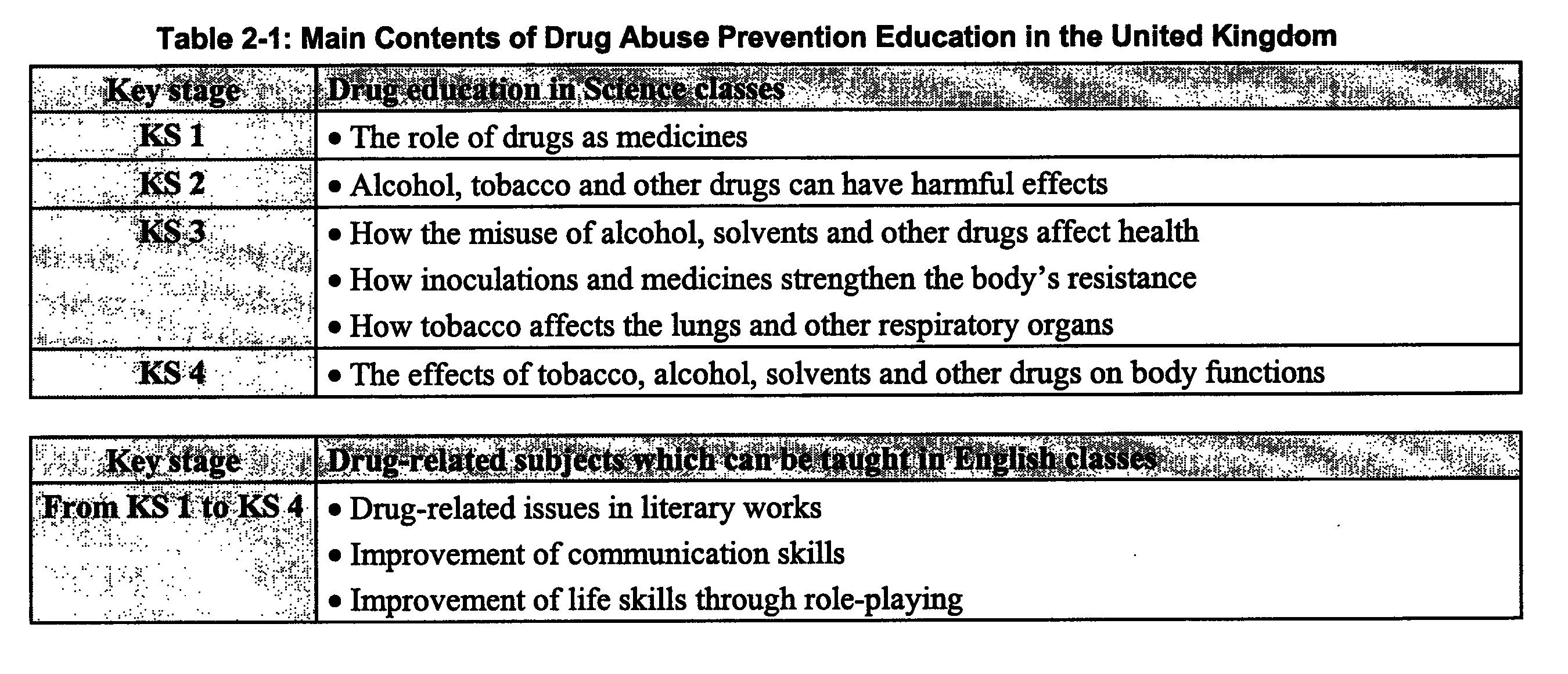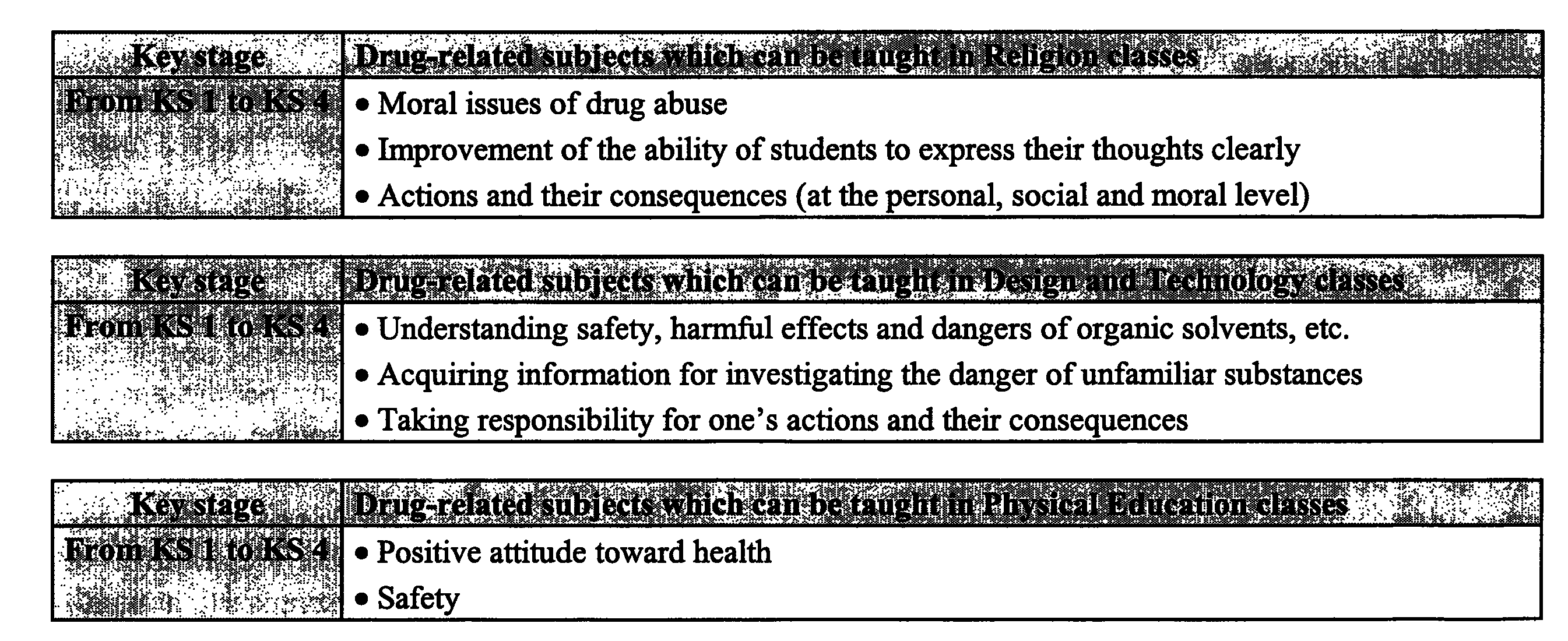| Home > Policy > White Paper, Notice, Announcement > White Paper > JAPANESE GOVERNMENT POLICIESIN EDUCATION, SCIENCE, SPORTSAND CULTURE1998 > MENTAL AND PHYSICAL HEALTH AND SPORTS CHAPTER2 SECTION3 4 | ||
Drug abuse by young people is a problem faced not only by Japan but is also a serious social problem throughout the world.Every nation is in the process of carrying out a variety of measures aimed at drug abuse prevention.Schoolbased education is considered one of the major areas among these measures.
Drug abuse in the United States has been decreasing in recent years.According to a1996study by the National Institute on Drug Abuse,6.1%of all Americans aged12years or older(13million people)were abusing drugs at that time(had illegally abused drugs within the previous month).The fact that this figure has dropped to roughly half the national record of14.1%(25million people)set in1979is in large part due to the National Drug Control Strategy,which has been carried out on an annual basis since1989.Nonetheless,with34.8%of its citizens aged12and over reporting that they have abused drugs in their lives,the United States still is wrestling with a serious drug problem.In particular,the ratio of young people abusing drugs,mainly marijuana,remains high.The United States Government announced the following five targets for the National Drug Control Strategy for1998.The first target is the enhancement of education on drug abuse prevention aimed at young people.$1.76billion(110/o)of the nearly$16billion annual drugrelated budget is devoted to education on drug abuse prevention.
In the United States,each state,county,city and other local government adopts its own drug abuse prevention education program which is carried out at local schools.Although there are currently46drug abuse prevention education programs being carried out at the national level,these are being developed by a wide variety of organizations,including universities,policerelated organizations,private health education organizations and groups organized by parents and guardians.Since there is no uniform program,the United States Department of Education is developing the basic policy for drug abuse prevention education by designating"Learning to Live Drug Free"as a model drug education program in schools."Learning to Live Drug Free"aims not only to have children accumulate knowledge and awareness of drugs geared toward their stage of growth and development,but also to help children develop life skills to include self-esteem,the maintenance of good relationships with other people,stress management,the development of decisionmaking skills and the learning of methods for resisting the temptation of drug abuse.The curriculum is split into four parts:kindergarten to third grade(ages5-8),fowth grade to sixth grade(ages9-11),seventh and eighth grades(ages12and13),and ninth grade to twelfth grade(ages14-17).Course materials are not only covered by health,science and other courses which directly cover drugs,but also by language,matbematics,performing arts and other subjects.Each year,the Department of Education also recognizes several schools as"Drug-Free Schools"as part of its effort to promote education on drug abuse prevention.In the United States,various types of Iargescale epidemiology studies are carried out almost annually in order to grasp the real state of drug abuse.The results of these studies are provided as basic materials for developing curricula for education on drug abuse prevention.In addition,these studies are considered as evaluation systems for monitoring the effectiveness of drug abuse prevention education at schools.Representative of these studies is the latest report,"Monitoring the Future,"which reveals that drug(mainly marijuana)abuse by eighth to twelfth graders(14-to18-year-olds),which had been continually increasing since1992,leveled off in1997.The report also states that this year,children's awareness of the danger of drug abuse as well as negative attitudes toward drug abuse-two factors which are indicators that predict the spread of drug abuse-had increased for the first time in several years.These results indicate that the United States'efforts at drug abuse prevention education is bearing some fruit.
In recent years,the United Kingdom has seen younger drug abusers and diversification of abuse.Furthermore,the spread of drug abuse is exceeding sexual,racial and social categories.In response to these problems,in1995the British Government devised new comprehensive measures aimed at drug abuse prevention expressed in a white paper entitled Tackling Drugs Together.These comprehensive measures are focused on crime,and youth and public health.In particular,the measures are aimed at preventing drug abuse by educating young people and by improving the social enviromnent in which at present it is easy to obtain illegal drugs.In response to the suggestions made in the white paper,in May1995the Deparhnent of Education and Employment prepared a handbook for instructing drug abuse prevention at schools.Two items considered important in this handbook are accurate new information regarding drugs and health,and learning opportunities aimed at improving communication,decisionmaking and other aspects of children's life skills,and raising self-esteem.Education on drug abuse prevention is covered mainly in Science classes,but is also handled in English,Religion,Design and Technology,Sociology and Physical Education classes.The British compulsory education system divides school years into four Key Stages(KS),each of which is aimed at a particular stage of development and establishes curricula and content accordingly.The main contents of drug abuse prevention education for KSI(ages5-7),KS2(age7-11),KS3(ages1114)and KS4(ages14-16)are shown in Table2-1.


Drug abuse by young people is also on the increase in France.Recently the abuse of amphetamines and other new drugs has increased dramatically,in addition to mafijuana,inhalants(such as organic solvents and glue)and other conventionally abused drugs.A1993study by the French Institute of Health and Medical Research revealed that the abuse of illegal drugs by young people is closely related to tobacco and alcohol use.In1980,a Committee on Drug Abuse Prevention was formed in the French Cabinet,with the Prime Minister as Chair and all Cabinet ministers as members.Since then,government ministries have been working together to draft and carry out measures to prevent drug abuse.The three main areas behind these measures are:1)cracking down on illegal drugs(reducing the supply of drugs),2)preventing drug abuse(reducing the demand for drugs through preventive education),and3)medical treahnent of dmg dependency.Drug abuse prevention education at schools falls mainly under area2)above.In response to the results of the study by the French Institute of Health and Medical Research,the establishment of a comprehensive prevention program for all abuse is being advanced based on the understanding that drug abuse is considered a danger for young people alongside smoking and drinking alcohol.Drug abuse prevention education is aimed mainly at lower and upper secondary school students.The Ministry of National Education determines the outlines of drug abuse prevention education curricula,and also holds national training sessions concerning drug abuse prevention aimed at teachers and contributors outside of schools(nurses,police officers,etc.),as well as lectures at schools by instructors on drug abuse prevention education.Specific drug abuse prevention education curricula are put together by each school and are instructed mainly through Physical Education,Biology,Civics and other classes,and also during free discussion time.Instuction is sometimes made through team teaching-instuction by more than one teacher.There is no set number of hours required for drug abuse prevention education.Since this decision is left to each school's discretion,some schools which have not been designated by the Ministry of National Education as"a school promoting drug abuse prevention education"are not necessarily tackling this subject positively.It has been pointed out that behind this problem is concern on the part of these schools that promoting drug abuse prevention education will leave themselves open to the opinion that their school has a drug abuse problem.
| Back to Top | MEXT HOME |